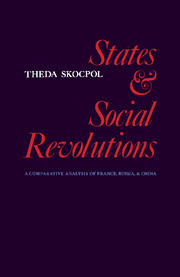Book contents
- Frontmatter
- Dedication
- Contents
- List of Tables and Maps
- Preface
- Introduction
- Part I Causes of Social Revolutions in France, Russia, amd China
- Part II Outcomes of Social Revolutions in France, Rusia, and China
- 4 What Changed and How: A Focus on State Building
- 5 The Birth of a “Modern State Edifice” in France
- 6 The Emergence of a Dictatorial Party-State in Russia
- 7 The Rise of a Mass-Mobiliang Party-State in China
- Conclusion
- Notes
- Bibliography
- Index
4 - What Changed and How: A Focus on State Building
Published online by Cambridge University Press: 05 August 2014
- Frontmatter
- Dedication
- Contents
- List of Tables and Maps
- Preface
- Introduction
- Part I Causes of Social Revolutions in France, Russia, amd China
- Part II Outcomes of Social Revolutions in France, Rusia, and China
- 4 What Changed and How: A Focus on State Building
- 5 The Birth of a “Modern State Edifice” in France
- 6 The Emergence of a Dictatorial Party-State in Russia
- 7 The Rise of a Mass-Mobiliang Party-State in China
- Conclusion
- Notes
- Bibliography
- Index
Summary
Every great revolution has destroyed the State apparatus which it found. After much vacillation and experimentation, every revolution has set another apparatus in its place, in most cases of quite a different character from the one destroyed; for the changes in the state order which a revolution produces are no less important than the changes in the social order.
Franz BorkenauSocial-revolutionary crises in France, Russia, and China set in motion political and class struggles that culminated in fundamental and enduring structural transformations. Important patterns of change were common to all three Revolutions. Peasant revolts against landlords transformed agrarian class relations. Autocratic and protobureaucratic monarchies gave way to bureaucratic and mass-incorporating national states. The prevolutionary landed upper classes were no longer exclusively privileged in society and politics. They lost their special roles in controlling the peasants and shares of the agrarian surpluses through local and regional quasi-political institutions. Under the Old Regimes, the privileges and the institutional power bases of the landed upper classes had been impediments to full state bureaucratization and to direct mass political incorporation. These impediments were removed by the political conflicts and class upheavals of the revolutionary interregnums. At the same time, emergent political leaderships were challenged by disunity and counterrevolutionary attempts at home, and by military invasions from abroad, to build new state organizations to consolidate the Revolutions.
- Type
- Chapter
- Information
- States and Social RevolutionsA Comparative Analysis of France, Russia and China, pp. 161 - 173Publisher: Cambridge University PressPrint publication year: 1979
- 1
- Cited by



